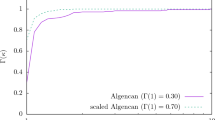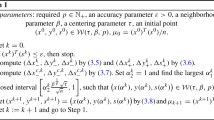Abstract
We propose an entire space polynomial-time algorithm for linear programming. First, we give a class of penalty functions on entire space for linear programming by which the dual of a linear program of standard form can be converted into an unconstrained optimization problem. The relevant properties on the unconstrained optimization problem such as the duality, the boundedness of the solution and the path-following lemma, etc, are proved. Second, a self-concordant function on entire space which can be used as penalty for linear programming is constructed. For this specific function, more results are obtained. In particular, we show that, by taking a parameter large enough, the optimal solution for the unconstrained optimization problem is located in the increasing interval of the self-concordant function, which ensures the feasibility of solutions. Then by means of the self-concordant penalty function on entire space, a path-following algorithm on entire space for linear programming is presented. The number of Newton steps of the algorithm is no more than \(O(nL\log (nL/ {\varepsilon }))\), and moreover, in short step, it is no more than \(O(\sqrt{n}\log (nL/{\varepsilon }))\).
Similar content being viewed by others
References
Grotschel, M., Lovasz, L., Schrijver, A.: The ellipsoid method and its consequences in combinatorial optimization. Combinatorica 1(2), 169–197 (1981)
Frenk, J.B.G., Gromicho, J., Zhang, S.: A deep cut ellipsoid algorithm for convex programming: theory and applications. Math. Program. 63(1–3), 83–108 (1994)
Kort, B.W., Bertsekas, D.P.: A new penalty function method for constrained minimization. In: Proceedings of the IEEE Conference on Decision and Control (New Orleans, 1972), pp. 162–166 (1972)
Cominetti, R.: Asymptotic convergence of the steepest descent method for the exponential penalty in linear programming. J. Convex Anal. 2(1–2), 145–152 (1995)
Alvarez, F., Cominetti, R.: Primal and dual convergence of a proximal point exponential penalty method for linear programming. Math. Program. Ser. A 93, 87–96 (2002)
Fang, S.C., Tsao, H.S.J.: On the entropic perturbation and exponential penalty methods for linear programming. J. Optim. Theory Appl. 89(2), 461–466 (1996)
Polyak, R.: Modified barrier functions. Math. program. 54, 177–222 (1992)
Griva, I.: Numerical experiments with an interior-exterior point method for nonlinear programming. Comput. Optim. Appl. 29(2), 173–195 (2004)
Kort, B.W., Bertsekas, D.P.: Multiplier methods for convex programming. In: Proceedings IEEE Conference on Decision and Control, San Diego, California, pp. 428–432 (1973)
Tseng, P., Bertsekas, D.: On the convergence of the exponential multipliers method for convex programming. Math. Program. 60, 1C19 (1993)
Polyak, R., Teboulle, M.: Nonlinear rescaling and Proximal-like methods in convex optimization. Math. program. 76, 265–284 (1997)
Polyak, R.: Nonlinear rescaling vs. smoothing technique in convex optimization. Math. Program. Ser. A 92, 197–235 (2002)
Yamashita, H., Tanabe, T.: A primal-dual exterior point method for nonlinear optimization. SIAM J. Optim. 20(6), 3335–3363 (2010)
Polyak, R., Griva, I.: Primal-dual nonlinear rescaling method for convex optimization. J. Optim. Theory Appl. 122(1), 111–156 (2004)
Polyak, R.: Primal-dual exterior point method for convex optimization. Optim. Methods Softw. 23(1), 141–160 (2007)
Griva, I., Polyak, R.: 1.5-Q-superlinear convergence of an exterior-point method for constrained optimization. J. Global Optim. 40(4), 679–695 (2008)
Griva, I., Polyak, R.: Primal-dual nonlinear rescaling method with dynamic scaling parameter update. Math. Program. Ser. A 106, 237–259 (2006)
Nesterov, Y., Nemirovskii, A.: Interior-Point Polynomial Methods in Convex Programming. Society for Industrial and Applied Mathematics (1994)
Renegar, J.: A Mathematical View of Interior-Point Methods in Convex Optimization. Society for Industrial and, Applied Mathematics (2001)
Boyd, S., Vandenberghe, L.: Convex Optimization. Cambridge University Press, Cambridge (2004)
Wright, M.H.: The interior-point revolution in optimization: history, recent developments, and lasting consequences. Bull. Am. Math. Soc. 42, 39–56 (2005)
Karmarkar, N.K.: A new polynomial time algorithm for linear programming. Combinatorica 4, 373–395 (1984)
Danchi, J., Moore, J.B., Huibo, J.: Self-concordant functions for optimization on smooth manifolds. J. Global Optim. 38(3), 437–457 (2007)
Bercu, G., Postolache, M.: Class of self-concordant functions on Riemannian manifolds. Balkan J. Geom. Appl. 14(2), 13–20 (2009)
Quiroz, E.A., Oliveira, P.R.: New Results on Linear Optimization Through Diagonal Metrics and Riemannian Geometry Tools, Technical Report ES-654/04. Federal University of Rio de Janeiro, PESC COPPE (2004)
Roos, C., Mansouri, H.: Full-Newton step polynomial-time methods for linear optimization based on locally self-concordant barrier functions(Manuscript). Department of Electrical Engineering, Mathematics and Computer Science, Delft University of Technology, The Netherlands (2006)
Jin, Z., Bai, Y.: Polynomial-time interior-point algorithm based on a local self-concordant finite barrier function. J. Shanghai Univ. 13(4), 333–339 (2009). (English edition)
Kojima, M., Megiddo, N., Mizuno, S.: A primal-dual infeasible-interior-point algorithm for linear programming. Math. Program. 61(1–3), 263–280 (1993)
Salahi, M., Terlaky, T., Zhang, G.: The complexity of self-regular proximity based infeasible IPMs. Comput. Optim. Appl. 33(2), 157–185 (2006)
Roos, C.: A full-Newton step O(n) infeasible interior-point algorithm for linear optimization. SIAM J. Optim. 16(4), 1110–1136 (2006)
Mansouri, H., Roos, C.: Simplified O(nL) infeasible interior-point algorithm for linear optimization using full-Newton step. Optim. Methods Softw. 22(3), 519–530 (2007)
Burke, Jim, Song, Xu: A non-interior predictor-corrector path following algorithm for the monotone linear complementarity problem. Math. Program. 87(1), 113–130 (2000)
Zhao, Yun-Bin, Li, Duan: A globally and locally superlinear convergent non-interior-point algorithm for $P_{0}$ LCPS. SIAM J. Optim. 13(4), 1195–1221 (2003)
Hotta, K., Inaba, M., Yoshise, A.: A complexity analysis of a smoothing method using CHKS-function for monotone linear complementarity problems. Comput. Optim. Appl. 17, 183–201 (2000)
Burke, J., Xu, S.: Complexity of a noninterior path-following method for the linear complementarity problem. J. Optim. Theory Appl. 112(1), 53–76 (2002)
Nesterov, Y.: Constructing Self-Concordant Barriers for Convex Cones (March 2006). CORE Discussion Paper No. 2006/30. Available at SSRN: http://ssrn.com/abstract=921790
Shevchenko, O.: Recursive construction of optimal self-concordant barriers for homogeneous cones. J. Optim. Theory Appl. 140(2), 339–354 (2009)
Papa Quiroz, E.A., Oliveira, P.R.: New Self-Concordant Barrier for the Hypercube. J. Optim. Theory Appl. 135(3), 475–490 (2007)
Renegar, J.: A polynomial-time algorithm, based on Newton’s method, for linear programming. Math. Program. 40(1–3), 59–93 (1988)
Rockafellar, R.T.: Convex Analysis. Princeton University Press, Princeton (1970)
Alexandrov, A.D.: Convex Polyhedra. Springer, Berlin (2005)
Khachiyan, L.G.: A Polynomial Algorithm in Linear Programming. Doklady Akademiia Nauk SSSR, 244,1093C1096 (1979). (English translation: Soviet Mathematics Doklady, 20(1),191C194 (1979))
Gács, P., Lovász, L.: Khachian’s algorithm for linear programming. Math. Program. Study 14, 61–68 (1981)
Author information
Authors and Affiliations
Corresponding author
Rights and permissions
About this article
Cite this article
Tian, D.G. An entire space polynomial-time algorithm for linear programming. J Glob Optim 58, 109–135 (2014). https://doi.org/10.1007/s10898-013-0048-z
Received:
Accepted:
Published:
Issue Date:
DOI: https://doi.org/10.1007/s10898-013-0048-z




